Pennsylvania Avenue DC planning initiative
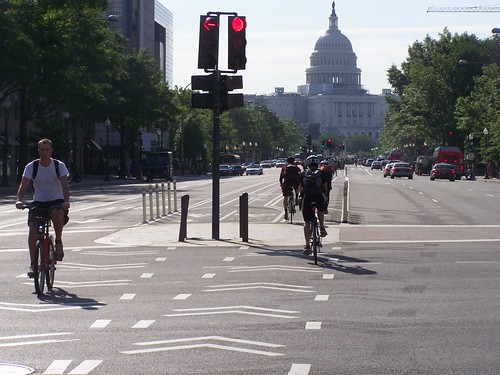
The Washington Business Journal reports in "Pennsylvania Avenue is in a slump, but there's a plan to breathe new life into it" that the National Capital Planning Commission is initiating a planning study to improve Pennsylvania Avenue NW, as a reassessment and updating of that street's improvement program.
(A few years ago at an NCPC hearing, I spoke extemporaneously in response to the statement about Pennsylvania Avenue being "America's Main Street," stating that the urban design and placemaking experience there is horrible and that it should be addressed to make real the perception, presuming of course that a "Main Street" is supposed to be a quality experience, not a bad one.)
The first meeting will be
Pennsylvania Avenue NW was "urban renewed" via the Pennsylvania Avenue Development Corporation, an urban renewal initiative by the federal government launched by President Kennedy, in response to the evident decline of the experience of the street.
Mostly, the urban renewal program resulted in the construction of large buildings on superblocks and parks and open spaces (e.g. Pershing Park or Freedom Plaza) that don't work very well, while eradicating most of the retail--with all of the buildings on the south side of Pennsylvania being federal buildings, with zero retail, with the exception of the Old Post Office.
"Commerce is the engine of urbanism."
-- Alex Wall, in his book about Victor Gruen, entitled From Urban Shop to New City
As a result, except for the north side of Pennsylvania at 7th Street which is mostly commercial and has ground floor retail, including a Starbucks, the street is forlorn.
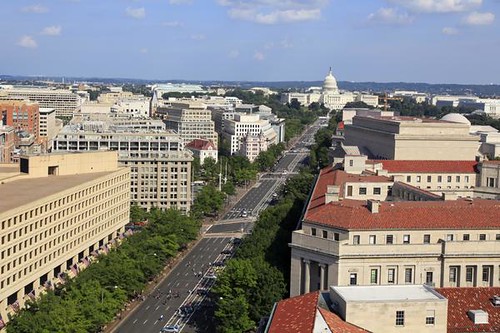
Before the urban renewal program, the building stock was variegated, some federal buildings, mostly on the south side of the street, while the north side of the street was comprised of a wide variety of small commercial buildings with retail on the ground floor.
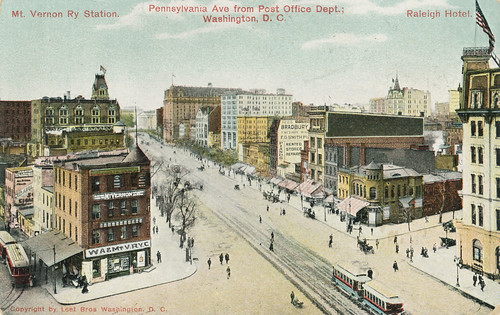
1300 block of Pennsylvania Avenue NW, north side
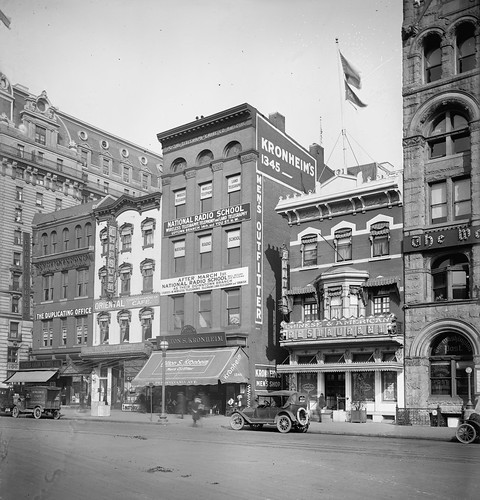
Freedom Plaza, today (Wikipedia photo)
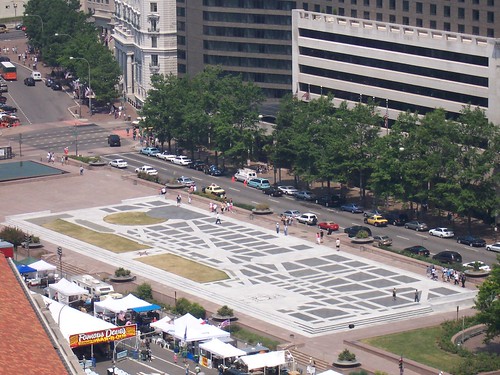
The site of Freedom Plaza in 1958 (DDOT photo)
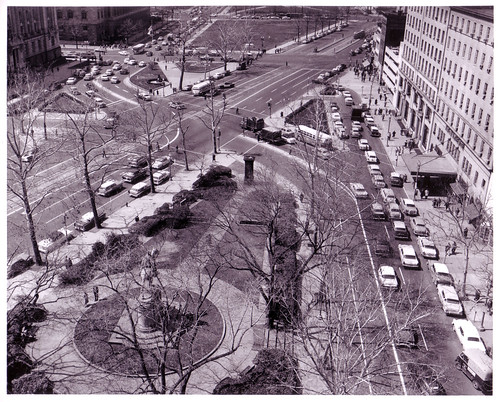
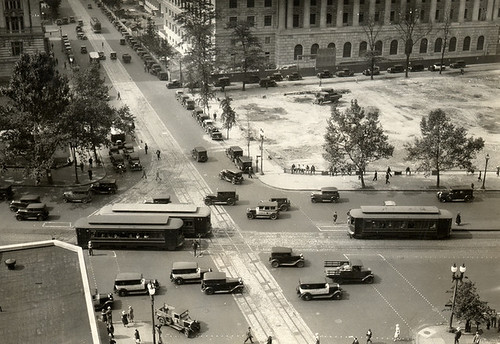
Automobiles and trolleys near Pennsylvania and 14th St. in Washington, D.C., circa 1933. Washington Post photo.
When I first read Death and Life of Great American Cities, I was "surprised" that Jane Jacobs was not a fan of the "City Beautiful" movement, which brought "order" to American civic centers, through the construction of large buildings, mostly employing Beaux Arts architecture--Washington's Union Station being a leading example--parks improvements, and public art, especially statues.
But over time I figured out her criticisms made sense, that City Beautiful wasn't intended to engage people and support action and energy on the street, it was designed to be awe-inspiring and at the same time, distant.
It's a struggle balancing majesty and activity.
Pennsylvania Avenue's urban renewal paradigm of large buildings and unfriendly public spaces is a derivative of the large block and building planning approach common to the City Beautiful movement (and Baron Haussmann in Paris before that).
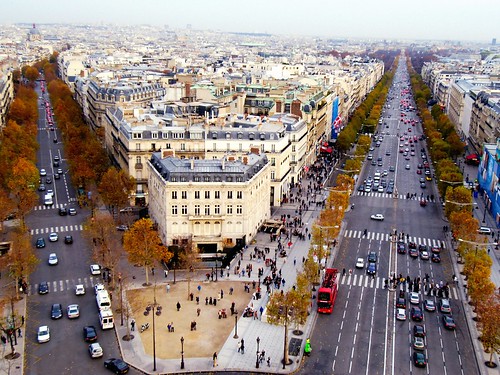
Champs Elysees, Paris, France. Image: City Pictures.
According to the WBJ article, rents and sales prices/s.f. for commercial spaces on the corridor are significantly lower compared to more central locations in the core of Downtown, the vacancy rate is almost 12%, 40% of the space is used by law firms and many are leaving (that sector is going through serious consolidation at the moment) which will double the vacancy rate.
Typically, office districts are barren of activity at night and Pennsylvania Avenue is no exception. As businesses consolidate, many central business districts have converted office buildings to housing and hotels, adding a new dimension to those districts, by extending activity throughout the day and into the evening, when before districts were active only during the day.
F Street NW in the 1940s, when there was a lot more daily activity on Downtown streets, which at that time had few competitors elsewhere in the region.
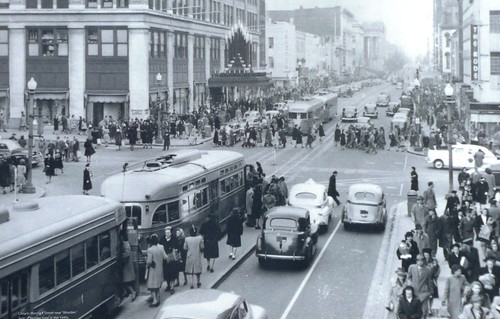
In the post 9-11 world, mixing uses between federal and non-federal within the same building footprint is likely impossible because of security concerns. So to enliven the corridor, more non-federal uses need to be added.
The general problems are that:
- the street is too wide
- most of the first floor spaces are office space and pedestrian-unfriendly
- there is limited housing
- the street is even emptier at night.
Typically office workers support a narrow range of retail (2 s.f. per person), mostly convenience, and a similarly narrow range of quick service restaurant and take out food--think Au Bon Pain or Subway (5 s.f. per person is the average).
Plus, federal workers tend to eat out less than the typical office worker--a recent study of workers in the Southwest district found that almost 65% of federal workers bring their lunch to work most days.
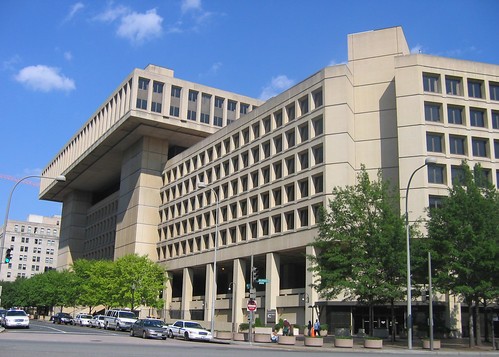
FBI Building, Wikipedia photo
Recent developments on the Pennsylvania Avenue corridor
1. The Newseum opened in 2008 at 6th and Pennsyvlania Avenue NW, and that has increased activity on the street somewhat, especially because each day they post newspaper front pages from around the US and certain other countries. But the museum, which charges, still has difficulty competing against the free museums on the National Mall.
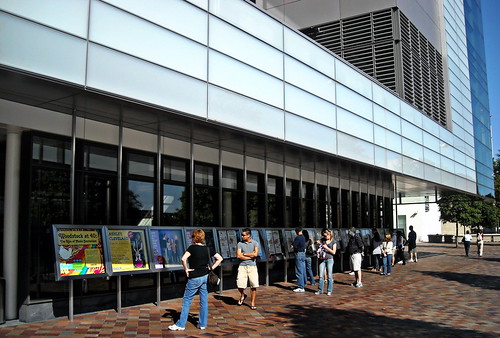
Newspaper pages displayed in front of the Newseum. Flickr photo by Josh.
2. Bike lanes were installed in the middle of the street, in 2010. In my opinion they don't work very well and if they had been installed on each side of the street in the right lane, it would have helped to reduce the perceived width of the street. ("D.C. opens Pennsylvania Avenue bike lanes," Washington Post)
3. The Old Post Office building is being converted into a hotel by Donald Trump. It had been a retail-office building but the retail failed--because of the other conditions present on the corridor and described above ("A Trump Makeover for Washington's Old Post Office," New York Times). For the hotel to be successful, there will need to be more activity centers along the street.
4. The FBI is going to be leaving the corridor and its space will be redeveloped, presumably in a mixed use fashion, and federal agency office space is unlikely to be a part of the program ("The FBI puzzle: The agency wants to move, but the numbers for a one-to-one swap don’t necessarily add up," Washington Business Journal). However, we won't see the end result for about 10 years. It will take 3-5 years to build a new campus for the FBI and for them to move, and another 3-5 years to redevelop the site.
Note that when the FBI gave tours (they stopped in 1999, even before 9/11, "Citing Threats, FBI Suspends Public Tours," New York Times), the tour made the FBI Building one of the top tourist destinations in the region. On the other hand, tourists weren't frequenting the district more generally, and the retail they supported was very limited, a McDonalds and a souvenir shop. The lesson here that developing a multi-faceted destination is difficult, that there is a fine line between visitation and economic development and touristification.
5. Some Congressmen have pushed the idea to give the Federal Trade Commission building to the National Gallery of Art, by relocating the FTC to another space. ("House lawmaker claims federal agencies blocked efforts to relocate FTC," Washington Business Journal).
To achieve street activation goals, this idea of expanding the NGA needs to be explored further. It would be expensive, but maybe Congress would sign off on the FTC remaining in the corridor, perhaps as part of a renewed FBI site, but in an upper story location in a mixed use building.
Other ideas for activating Pennsylvania Avenue
1. In order to maximize activation, I would argue that Pennsylvania Avenue should be planned in coordination with the National Mall. So my post on visitor management and the National Mall is relevant, "Parking under the National Mall should be part of an integrated approach to visitor services and management."
2. Years ago I suggested that in the summer, museum hours for the Smithsonian Institution facilities and the National Gallery of Art should be extended and promoted. They have been extended since I first wrote that ("Second Wednesdays on the National Mall?" and "Archives Redux") but not as late as I'd like.
And throughout the year, at least on one day per month, e.g., "Second Wednesdays," the Smithsonian Museums and the NGA should stay open till 9 or 10 pm.
3. And in parallel, there should be an effort to work with the nearby cinemas (Landmark, Regal on 7th Street) during the week (not weekends) to have "dusk" matinee pricing to extend people's stay in the vicinity of Downtown.
4. The Embassy of Canada should consider opening a cultural facility featuring the films and programming of the National Film Board of Canada ("Experimental film downtown"). A good model for comparison would be the Goethe Institut on 7th Street NW in the Gallery Place area. The Institut is the cultural organization for Germany and they provide a wide variety of cultural programming.including films, lectures, workshops, and language training.
5. The Smithsonian IMAX theater should be programmed to support later film showings, even midnite movies.
6. And the National Archives should be better marketed and programmed as well.
7. The newspaper front page program of the Newseum could be extended to the streetscape in front of the Embassy of Canada, featuring an expanded showing of newspapers from each of Canada's provinces, instead of the showing of one newspaper only (e.g., Montreal newspaper pages in French and English, Ottawa City, Quebec City, Edmonton, Winnipeg, Calgary, Vancouver--has two daily newspapers, Toronto--has four daily newspapers, Halifax, London and Windsor, Ontario, Saskatoon, Victoria, etc.
GSA Resource
-- This publication, Achieving Great Federal Public Spaces, was produced by the Project for Public Spaces in association with the General Services Administration, the property management arm of the federal government.
Labels: "streets as places", commercial district revitalization planning, cultural landscape, landscape architecture, parks and open space, urban design/placemaking



10 Comments:
great posting !! still- I am pushing for sidewalk bicycle tracks on pa Avenue- not in the road. There is more than enough space to do this and people aleady use the space between the planters and the curb- I was doing this over the weekend- it is safer than being exposed to car traffic in that death strip in the median.If "lanes" are put on the sides of the road as you advocate- then they should be separated with physcial obstructions of some kind for safety- in a way that would not threaten security for parades or processions.
Speaking of the National Mall, don't know if you saw this but it's pretty funny:
http://www.buzzfeed.com/bennyjohnson/the-7-most-heinously-ugly-government-buildings-in-washington
...and it led to this backstory article, which has garnered 340 comments arguing over freedom vs. security:
http://www.buzzfeed.com/bennyjohnson/why-you-should-not-take-photos-of-the-7-ugliest-buildings-in
-EE
thanks for those links. Great photos. Terrible story, but not a surprise. I have been stopped by cops taking photos of the Union Station railyard and at a school...
I'd be curious to know more about how the Champs Elysees "improved". It was as dead as Pennsylvania Avenue for a while.
And I think the bigger problem with Pennsylvania Avenue is all the commercial space is getting old at the same time, which means the biggest drivers of downtown office space (law firms) are bailing.
And you mention, government workers don't spend enough.
In terms of your previous entry, it looks like:
1) resurrect the PADC or create a new BID
2) Sidewalks are plenty wide
3) It is pretty walkable, but needs more shade
4) Not sure what you can do about the vacancy rate. There are a lot of corporation in the area (AES, Marriott, Advisory Board, Microstrategy) that could use a prestige address but clearly there are reasons they don't want to be in DC. FBI site could be good for this too, but I think we're going to get a lot of buildings torn down in the future.
5) Parking sucks there are a result of garages closing early
6) Civic / cultural anchor --big problem as well, although you have Navy memorial, archives, newseum, two theatres. Good suggestions on your part.
7) Traffic counts -- yes, on a bike i don't like being exposed in the middle. Also shade again. Could be a world class bike track but instead it is crap.
I was using the Champs Elysee as another example of a too wide street having problems, but also as an example of what happens on a street with big buildings.
... when you first started commenting on the blog, I had an article on the reaction in France to chain stores on the Champs Elysee and I think you commented. There at least it's more mixed use.
Wrt your points, as usual, they are great.
WRT the first one, while PADC was a good ($, focus and a commitment to action) and bad (superblock buildings, brutalist, dull) initiative, the Fed. Govt. and politicos focused on "shutting it down when it was done" not realizing that commercial district revitalization is a never ending story. So yes, a commercial district revitalization organization entity needs to be there and focus on the district, forever.
again, you make a great point about the "natural aging of the 'new' building stock" and the need for it to be refreshed "at the same time" and how this contributes to the vacancy issue, although I think the urban design is a big issue too.
wrt vacancy rate, I agree with you, and I meant to emphasize that the FBI vacation is going to worsen this considerably, because it potentially has the ability to add more commercial space to a corridor that has "too much now." (Although I think without focused recruitment--below--much of this would end up as retail on the ground floor with housing above.)
wrt your point about premier companies on the premier street, I think you're right about the difficulty in pulling this off given current conditions (you weren't here in the 1990s when people argued that NationsBank should move their hq from Charlotte to DC when they bought the various banks here, but there was no compelling business reason for them to do so) but extending your point in a creative way, a very interesting opportunity for business recruitment could be developed.
If you make the street totally great (shade, amenities, etc.) and as part of the FBI site recapture and maybe some other coordination of rebuilding opportunities, could you build recruiting a couple of those premier firms into the mix as anchor projects?
Comparable examples are Amazon in SoDo in Seattle, what's happening in the SoMA district in SF, how NSF was a research anchor along with the GMU branch campus in the Virginia Square to Ballston section of Wilson Blvd., and how Compuware moved from suburban Wayne County to Downtown Detroit and how this has helped to recruit other business headquarters there such as Quicken Loans--Dan Gilbert gets much of the current credit, but it was Peter Karmanos who was the first mover considerably ahead of most others (not Illitch).
PPS argues investment in place (like we are talking about for PA Ave.) was the key to success in Detroit.
The thing about Pennsylvania Avenue is that it has not absolutely the best transit, but it's pretty proximate to Metro Center and Gallery Place, making it pretty well connected even if it is only served by Archives Station directly. People just have to walk a couple blocks from Metro Center.
Anyway, your points are so important that I will work this into a follow up post.
HOWEVER, NCPC "and all the other agencies" aren't necessarily creative enough to pull off these kinds of ideas.
Plus, the great opportunity presented by the FBI move will take upwards of 10 years to realize, which is a problem...
... the Newseum hasn't been super successful as it too has a hard time competing with museums that don't charge, but when they decided to move to DC and buy a piece of DC Govt. property and pay a lot of money for it, more than $70 million, that was a big vote of confidence in the city just when the current "new order" was beginning to emerge.
It was as big a deal as Abe Pollin committing to DC for an arena for his sports teams.
Plus then the city was still "pretty poor" and it used the proceeds to fund revitalization programming like Main Streets.
Well CEB or the Advisory board would love to have that address; much like Covington used to like to have it. Others on my list I'd agree are long shots.
And I was trying to link that with tearing down some of the older buildings and putting it a signture buildings.
Between city center and F st, it is going to get harder to do retail downtown.
FWIW K st is going to have the same issues in about 5 years.
great point about K St.
very interesting blog,nice information.your work is very excellent.
Post a Comment
<< Home